
Bulletin
wall bulletinMenu
- Overview
- Country analysis
- Afghanistan
- Angola
- Argentina
- Australia
- Bangladesh
- Belarus
- Brazil
- Canada
- Germany
- Egypt
- Ethiopia
- France
- United Kingdom
- Hungary
- Indonesia
- India
- Iran
- Italy
- Kazakhstan
- Kenya
- Cambodia
- Sri Lanka
- Morocco
- Mexico
- Myanmar
- Mongolia
- Mozambique
- Nigeria
- Pakistan
- Philippines
- Poland
- Romania
- Russia
- Thailand
- Turkey
- Ukraine
- United States
- Uzbekistan
- Viet Nam
- South Africa
- Zambia
- Kyrgyzstan
Authors: 超级管理员 | Edit: zhuliang
This reporting period covers the main growing period of wheat. Its harvest concluded by the end of October. The harvest of maize in North-east is also ongoing while the harvest of rice in north and northeast and second maize in central and southern Brazil has concluded. The sowing of summer crops (maize, soybean, and rice) in Central and Southern Brazil started in October and will last until the end of December.
Overall dry and warmer-than-usual weather dominated the reporting period which was unfavorable for crops in Brazil. CropWatch Agro-climatic Indicators (CWAIs) present below-average conditions with 21% lower rainfall, 0.7°C higher temperature and 2% above average radiation compared with the 15YA. Significant below-average rainfall resulted in a 7% reduction of potential biomass. Dry weather conditions were wide-spread across all of Brazil with only four states receiving an above-average rainfall, including Distrito Federal (+41%), Espirito Santo (+33%), Bahia (+18%), and Rio De Janeiro (+2%). Some major agricultural producing states such as Sao Paulo, Mato Grosso Do Sul, Parana, Santa Catarina, Rio Grande Do Sul, and Mato Grosso suffered from water shortages with negative anomalies ranging from 33% to 22%. Similarly, temperatures in all states presented above-average conditions except for Ceará where temperatures remained at the 15YA level. The largest temperature anomalies were observed in Sao Paulo, Mato Grosso Do Sul, Parana, and Rondonia where temperatures were more than 1.0 ºC above average. Negative and positive anomalies of radiation were observed in different states with the largest positive departure in Alagoas at 10% above average and the largest negative departure in Acre, 3% below average. Low rainfall and high temperature resulted in water stress in central Brazil as indicated by the below average BIOMSS on the BIOMSS departure map.
According to the national rainfall profiles, the main rainy season usually starts in late September. This year's start was in mid-October only. As indicated by the 10-day accumulations of rainfall, precipitation was significantly below average from mid-July to mid-October except for mid-August. The low rainfall might exacerbate the sowing, emergence and early development of summer crops. For more detailed information, it is recommended to visit CropWatch Explore (http://cropwatch.com.cn/newcropwatch/main.htm).
The crop condition development graph based on NDVI for Brazil presents average values during July to August while it deteriorated to below average starting in September mainly due to the water stress. The chart showing proportions of different drought categories from July to October 2020 also indicates that the drought in Brazil got more severe as the proportion of drought affected areas increased from 17% in early September to 30% in late October. The adverse dry and hot weather hampered crop establishment as shown by the NDVI departure clustering maps and profiles. Most crops in Central Brazil stayed in below-average conditions throughout the growing season while southern Brazil presented close-to-average conditions. The drought condition in Mato Grosso, Parana, Sao Paulo and northwestern Rio Grande Do Sul adversely affected the crops as shown by significant decreasing trends of the NDVI departures (Red color in figure e). Accordingly, the VCIx map also presents low values (< 0.5) in central Brazil covering vast areas from Mato Grosso, Goias, Minus Gerias, to Sao Paulo (figure f). It is also noteworthy that crops in northeastern coast showed above-average conditions during the monitoring period as they benefited from the normal or above-average rainfall. At the national level, VCIx was 0.87 and CALF was 2% above the 5YA. Cropping intensity increased by 1% indicating that the total cultivated crop area was at an above-average level.
All in all, crop conditions in Brazil were below average and the establishment of the summer crops was delayed due to the drought conditions. However, wheat production in Parana and Rio Grande do Sul benefitted from rather favorable conditions. The map depicting the spatial distribution of NDVI profiles shows an above-average departure for the wheat production zones in those two states and an above-average wheat production is estimated. The establishment of the summer crops will mainly depend on sufficient rainfall in the coming months, as the season is starting with a considerable soil moisture deficit.
Regional analysis
Considering the differences of cropping systems, climatic zones and topographic conditions, eight agro-ecological zones (AEZ) are identified for Brazil. These include the Central Savanna, the east coast, Parana river, Amazon zone, Mato Grosso zone, Southern subtropical rangelands, mixed forest, and farmland, and the Nordeste. Similar to the dry weather pattern observed at the national level during the monitoring period, five zones including Amazonas, Northeastern mixed forest and farmland, Mato Grosso, Parana basin and Southern subtropical rangelands received significantly below-average rainfall (-19% to -37%). Temperature in each zone was higher than average with the largest temperature departure in Parana by 1.2 degree. Radiation in each zone was generally close to average ranging from average to 3% above average. As a result of the combined effects from rainfall, temperature and radiation, below average BIOMSS was observed in most zones except for Coast zone (+5% above average) and southern subtropical rangelands (no change).
Diversified agro-climatic conditions together with the human activities (farm managements, irrigation, etc) resulted in great differences of crop condition among AEZs. As indicated by the NDVI development profiles, below-average crop growth conditions were observed in Amazonas, Northeastern mixed forest and farmland, Mato Grosso, and Parana basin. Among the four zones with below-average conditions, Mato Grosso, and Parana basin are the two zones which showed the worst crop conditions mainly due to the prolonged dry conditions which was identified since October of last year. Accordingly, CALF in the two zones also presented below-average values that were 4% and 1% lower than 5YA while cropping intensity was 4% and 2% above average. The lowest two values of Maximum Vegetation Condition Index (VCIx) were observed in the two zones, Mato Grosso, and Parana.
Favorable agro-climatic conditions in Nordeste benefitted crops and resulted in above-average crop conditions as indicated by the NDVI-based crop development profiles. The Nordeste is the only zone that presented above-average NDVI throughout the growing season. Similar to that in the previous bulletin, the VCIx of Nordeste was the highest among the zones. It reached 1.22 indicating that crop conditions were better than during the last five years. Maize yield in the region is expected to be at record levels compared with the last 5 years. Thanks to favorable climatic conditions, cropped arable land fraction (CALF) in this zone was 43% above the 5YA. Nordeste presented the lowest cropping intensity among all the AEZs at 103%, with 4% lower than 5YA.
Average or close-to-average crop conditions were observed in the Central Savanna, and southern subtropical rangelands. However, weather conditions in the two zones greatly differed from each other. Central Savanna experienced above-average rainfall and close-to-average temperature and radiation. The rainfall was beneficial for crops as indicated by the significantly above-average CALF and high VCIx at 1.02. The above average rainfall will also be favorable for the sowing and early development of summer crops. In Southern subtropical rangelands, crops remained at average levels although rainfall was 28% below the 15YA. The main reason is that the zone still received 440 mm water during the monitoring period while winter crops already reached maturity stage by September and the rainfall was sufficient for the crop demand. BIOMSS and CALF were close to average and VCIx was 0.90 confirming the average conditions in the zone. Also, cropping intensity for the two AEZs were 4% and 13% above average.
Figure 3.11. Brazil's crop condition, July-October 2020
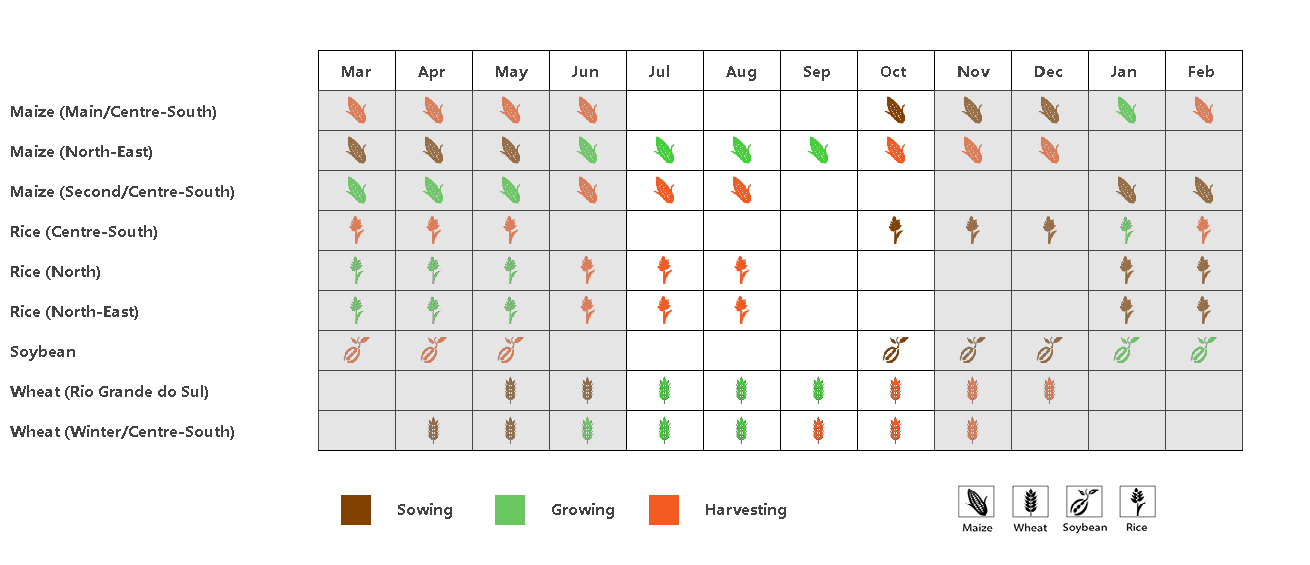
(a) Phenology of major crops

(b) Rainfall profile_Brazil
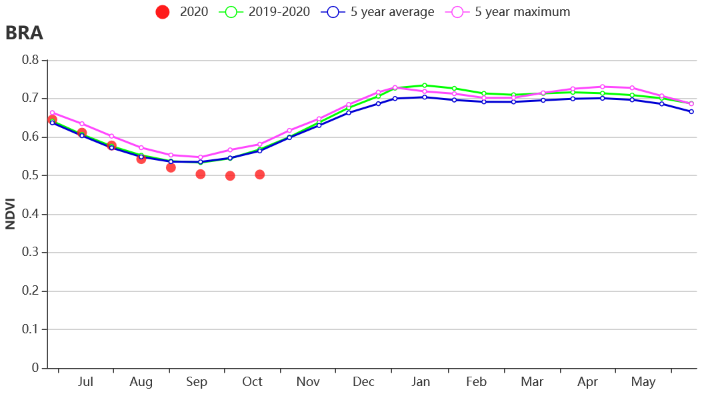
(c) Crop condition development graph based on NDVI_Brazil
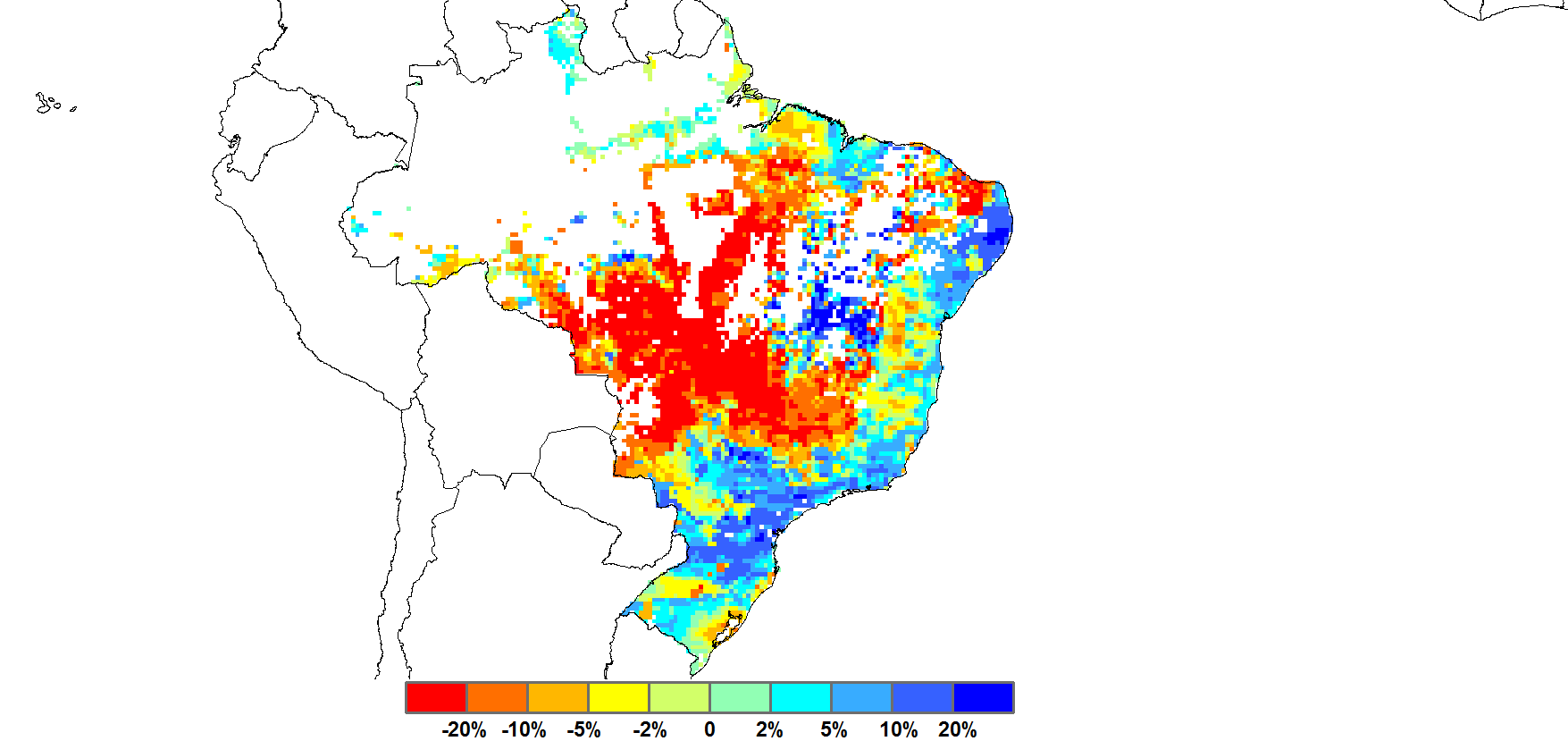
(d) Potential biomass departure from 15YA
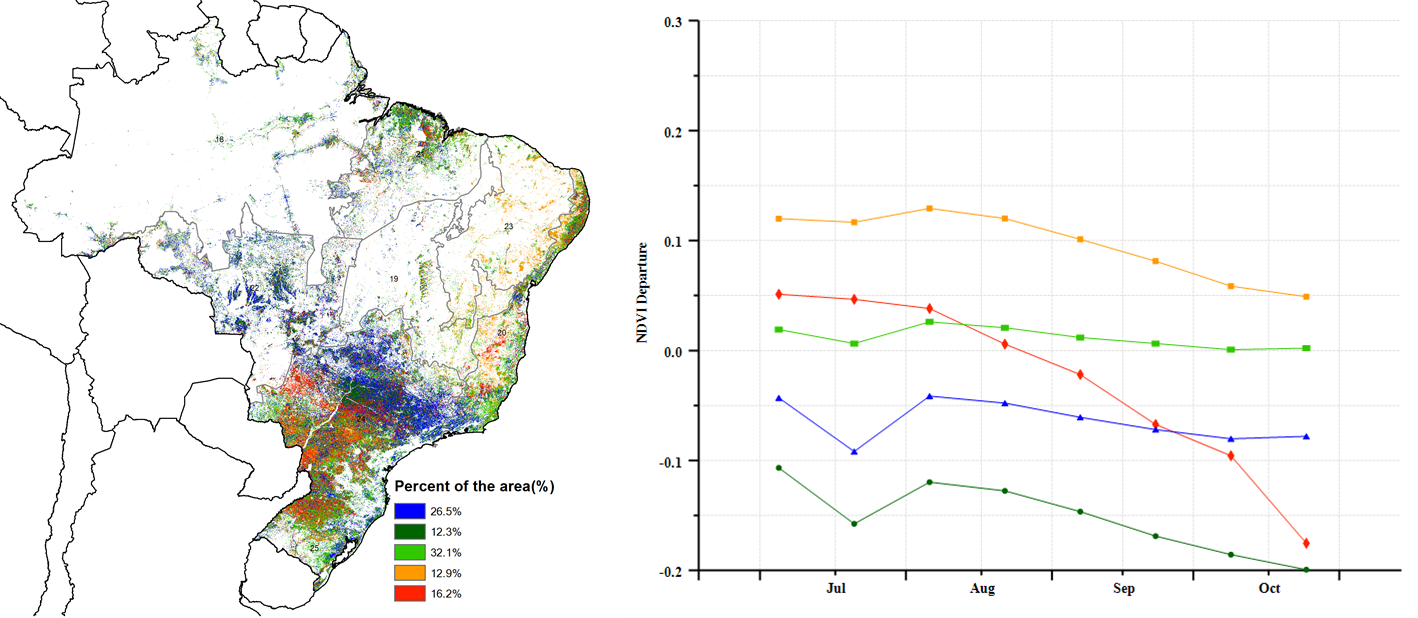
(e) Spatial distribution of NDVI departure profiles

(f) Maximum VCI
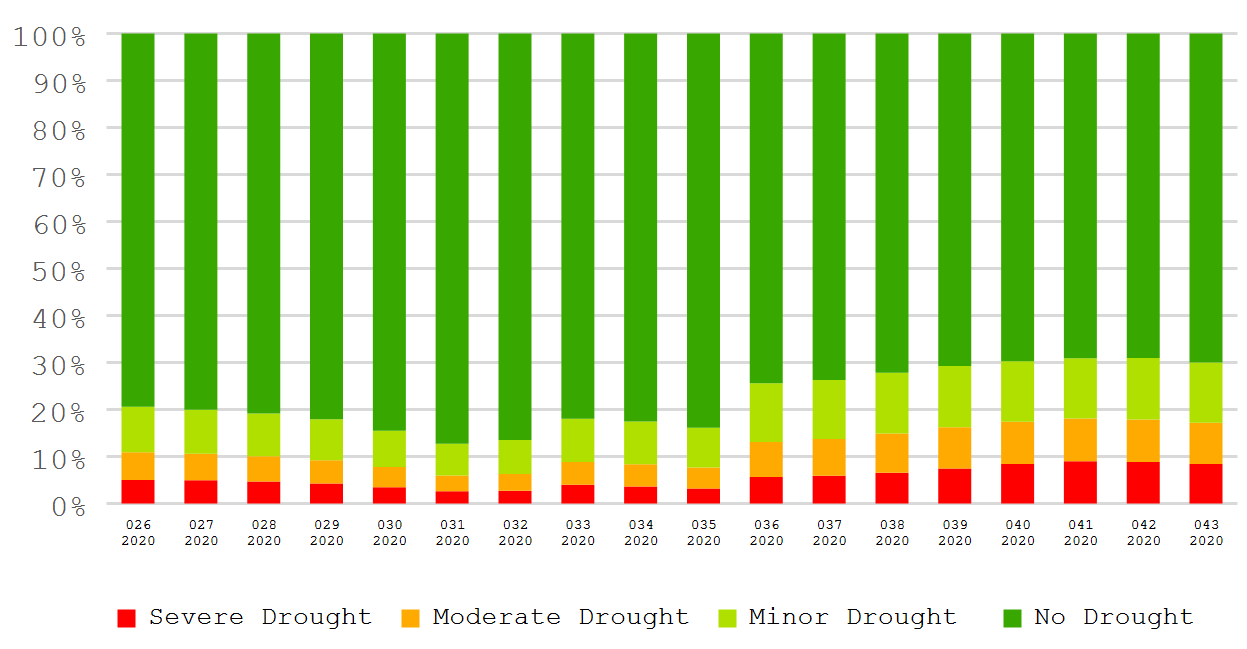
(g) Proportion of different drought categories from July to October 2020

(h) Crop condition development graph based on NDVI of Amazon
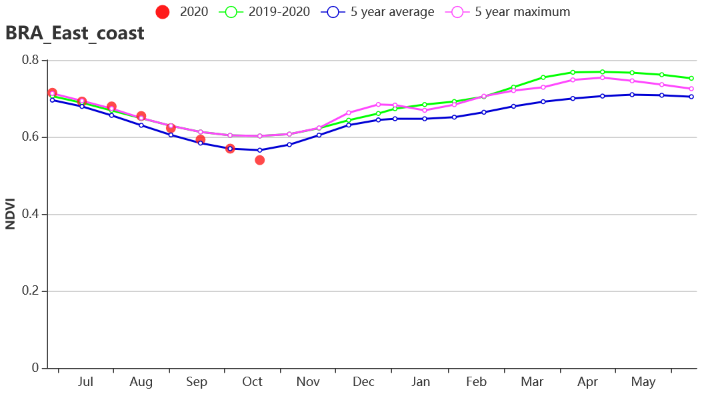
(i) Crop condition development graph based on NDVI of Coast

(j) Crop condition development graph based on NDVI of Mato Grosso Zone
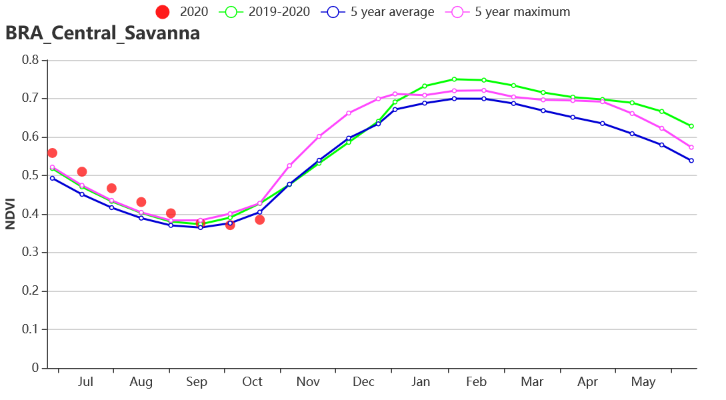
(k) Crop condition development graph based on NDVI of Central Savanna
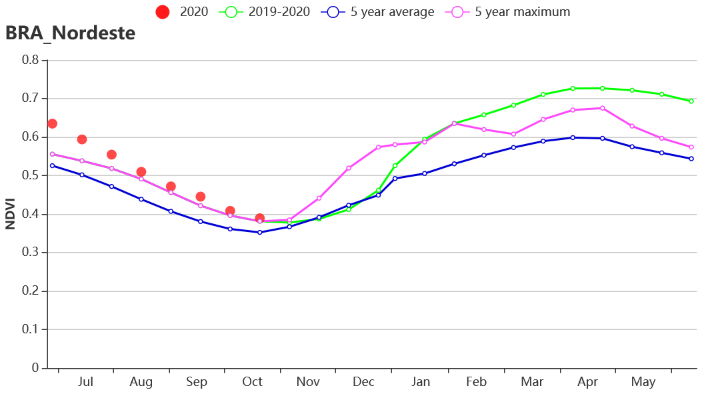
(L) Crop condition development graph based on NDVI of Nordeste

(m) Crop condition development graph based on NDVI of Northeastern mixed forest and farmland
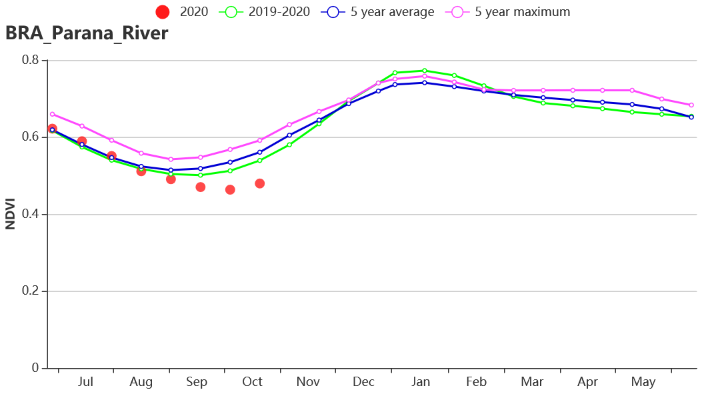
(n) Crop condition development graph based on NDVI of Parana River Basin
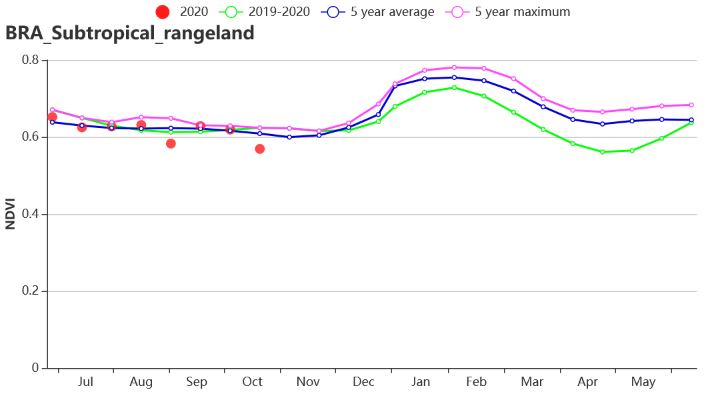
(o) Crop condition development graph based on NDVI of Southern Subtropical rangelands
Table 3.13 Brazil agro-climatic indicators by sub-national regions, current season's values and departure from 15 years average, July-October 2020
| RAIN | TEMP | RADPAR | BIOMSS | |||||
| States | Current value (mm) | Departure from 15YA (%) | Current value (℃) | Departure from 15YA (℃) | Current value (Mj/m²) | Departure from 15YA (%) | Current value (gDM/m²) | Departure from 15YA (%) |
| Amazonas | 324 | -19 | 27.2 | 0.5 | 1231 | 0 | 739 | -4 |
| Central Savanna | 196 | 18 | 24.5 | 0.1 | 1232 | 0 | 442 | -8 |
| Coast | 286 | 3 | 21.2 | 0.5 | 1020 | 2 | 592 | 5 |
| Northeastern mixed forest and farmland | 125 | -37 | 27.7 | 0.6 | 1275 | 0 | 671 | -8 |
| Mato Grosso | 183 | -23 | 27.0 | 0.9 | 1178 | 2 | 410 | -22 |
| Nordeste | 82 | 4 | 24.7 | 0.2 | 1259 | 1 | 633 | -2 |
| Parana basin | 293 | -26 | 21.4 | 1.2 | 1079 | 3 | 462 | -6 |
| Southern subtropical rangelands | 440 | -28 | 15.2 | 0.0 | 827 | 0 | 339 | 0 |
Table 3.14 Brazil agronomic indicators by sub-national regions, current season's values and departure from 5 years average, July-October 2020
| CALF | Cropping Intensity | Maximum VCI | |||
| States | Current value (%) | Departure from 5YA (%) | Current value (%) | Departure from 5YA (%) | Current value |
| Amazonas | 100 | 0 | 121 | 2 | 0.92 |
| Central Savanna | 87 | 35 | 118 | 5 | 1.02 |
| Coast | 100 | 2 | 109 | -3 | 0.94 |
| Northeastern mixed forest and farmland | 99 | 0 | 110 | -7 | 0.92 |
| Mato Grosso | 88 | -4 | 154 | 4 | 0.69 |
| Nordeste | 90 | 43 | 103 | -4 | 1.22 |
| Parana basin | 96 | -1 | 130 | 2 | 0.82 |
| Southern subtropical rangelands | 98 | 1 | 136 | 13 | 0.90 |
